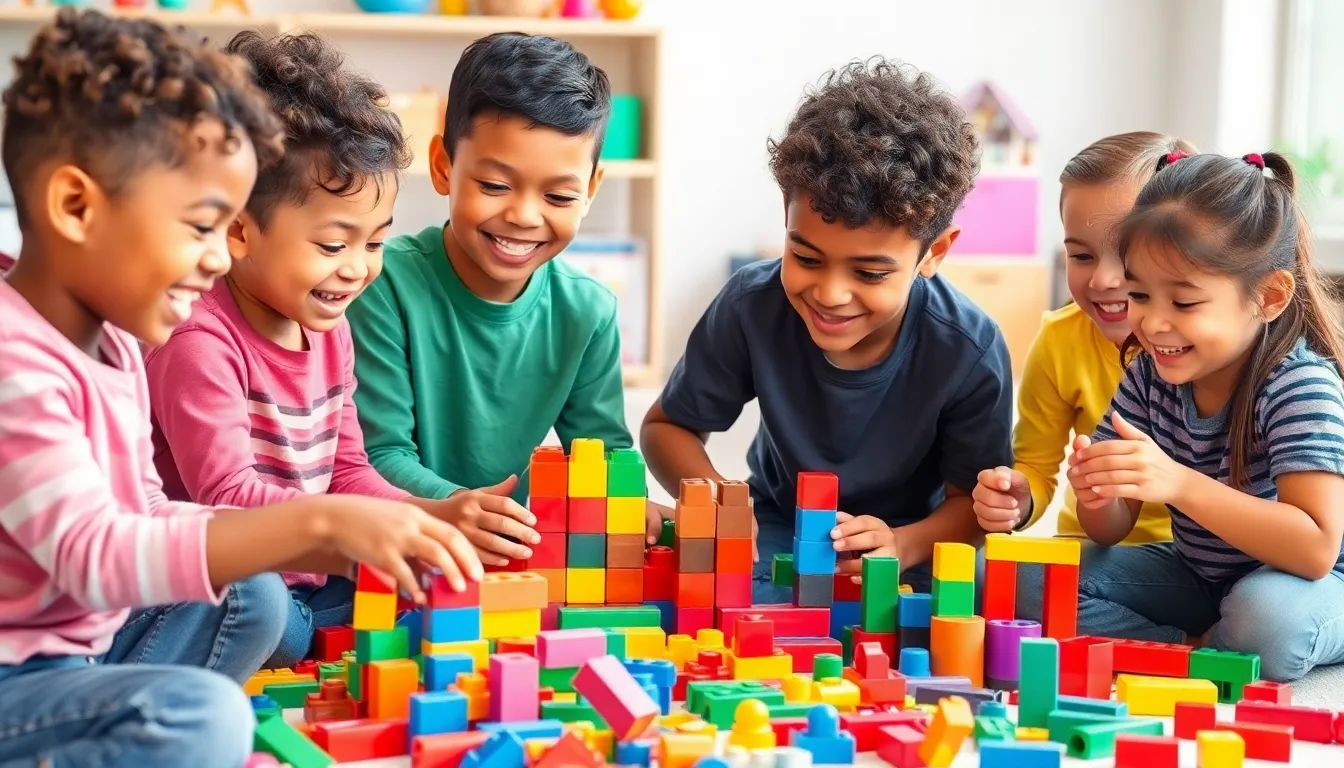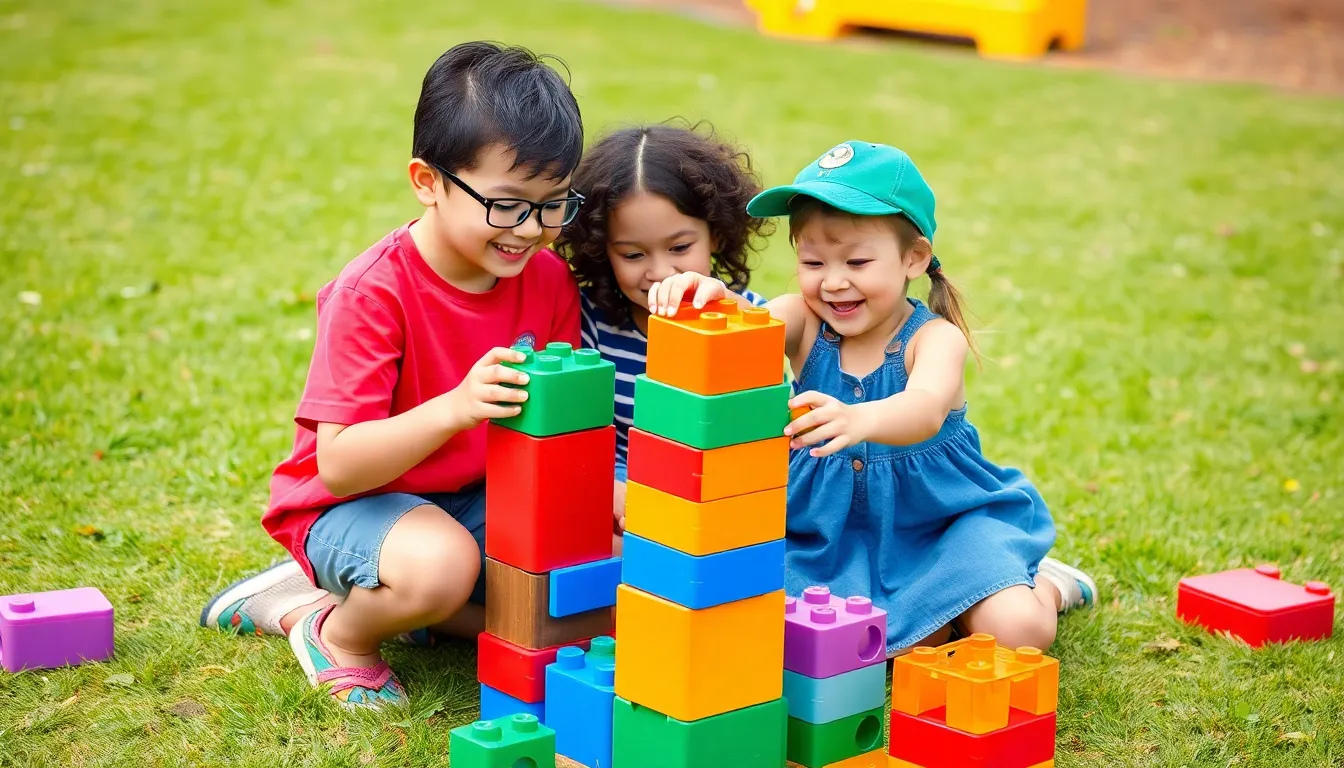Table of Contents
ToggleIn a world where screens often steal the spotlight, kids building games are the ultimate antidote. These games don’t just entertain; they spark creativity and imagination, turning little architects into master builders. Whether they’re stacking blocks or constructing entire cities in virtual realms, these activities offer a fun way to develop essential skills while keeping boredom at bay.
Imagine the joy on a child’s face as they proudly showcase their latest creation. With each block they stack or pixel they place, they’re not just playing—they’re learning the art of problem-solving and teamwork. So why let your child settle for another mindless app when they can dive into a world of building adventures? Kids building games are where fun meets education, and who wouldn’t want their child to build a future filled with creativity?
Overview of Kids Building Games
Kids building games enhance creativity and critical thinking skills. These activities encourage children to engage with materials, whether physical blocks or digital platforms. Various options exist, such as LEGO sets, construction apps, or outdoor play structures.
Hands-on building fosters motor skills and spatial awareness. Engaging in these games allows children to experiment with design concepts and structural integrity. Often, kids collaborate with peers, reinforcing teamwork and communication.
Progression through levels in virtual games cultivates perseverance and goal-setting. Players may face challenges requiring innovative solutions, which boosts problem-solving abilities. The satisfaction of completing a project generates a sense of accomplishment, promoting self-esteem.
Parents and educators recognize these games’ value in combining learning with play. Numerous building games integrate educational elements, such as math and engineering principles.
Selecting appropriate games based on age and interest ensures maximum engagement. Materials like wooden blocks or interactive software support varied skill levels. Both the tangible and virtual aspects provide diverse experiences that captivate young minds.
Overall, kids building games serve as a significant tool for growth. Their ability to blend fun with education positions them as crucial elements in a child’s development. Prioritizing these activities encourages exploration and imagination, laying a foundation for future creativity.
Benefits of Kids Building Games

Kids building games provide numerous advantages that enhance children’s development across various dimensions. Engaging in these activities enriches both cognitive and social growth.
Cognitive Development
Cognitive development significantly benefits from kids building games. These activities stimulate critical thinking and problem-solving abilities. Children confront challenges that require innovative solutions while constructing structures or solving puzzles. Engaging with materials like blocks or digital tools aids in developing spatial awareness and fine motor skills. Understanding concepts such as balance and symmetry emerges naturally through hands-on play. Experiential learning encourages exploration, leading to increased confidence and creativity as kids master new skills and concepts.
Social Skills Enhancement
Social skills enhancement occurs through collaborative play in building games. Children often work with their peers, fostering communication and teamwork. Sharing ideas and responsibilities cultivates a spirit of cooperation, essential in both social and academic settings. They learn conflict resolution as they navigate differing opinions during gameplay. Encouraging interaction during group projects further promotes empathy and respect for diverse perspectives. Such skills contribute not only to personal growth but also to creating supportive communities among young learners.
Popular Kids Building Games
Kids building games come in various forms, each offering unique benefits. Engaging in these games provides creativity, problem-solving, and social skills development.
LEGO Sets
LEGO sets stand out as a classic choice for children. These colorful bricks encourage imaginative play while promoting fine motor skills. They allow kids to construct everything from simple structures to complex vehicles. With themed sets like LEGO City and LEGO Friends, children explore different worlds. Building with LEGO challenges them to follow instructions or design their own creations. Customization possibilities spark innovation and individual expression. Moreover, collaborative play with peers enhances social connections and communication skills. LEGO’s adaptability makes it suitable for various ages, ensuring long-lasting engagement.
Digital Building Apps
Digital building apps present a modern take on construction play. These applications, such as Minecraft and Roblox, offer virtual environments where kids can design and create freely. Players engage in diverse projects, from architectural designs to entire cities. Interactive elements allow for collaboration with friends, fostering teamwork and negotiation. Adaptive challenges keep children engaged while developing strategic thinking and problem-solving abilities. Mobile accessibility allows for play anywhere, extending creative opportunities beyond traditional settings. Overall, the fusion of technology and creativity empowers kids to innovate in a digital realm.
Tips for Choosing the Right Building Game
Consider age-appropriateness when selecting a building game. Different games cater to various age groups, ensuring challenges align with developmental stages. Look for games with straightforward instructions that engage children without overwhelming them.
Evaluate the type of materials involved. Physical building sets, like LEGO, encourage tactile engagement and creativity. Digital building games, such as Minecraft, offer interactive experiences that enhance problem-solving skills through virtual environments.
Assess the game’s complexity. Games offering levels of difficulty allow kids to progress at their own pace. With escalating challenges, children remain motivated while developing critical thinking abilities.
Prioritize games that promote collaboration. Multiplayer options can help foster teamwork and communication among peers. As children build together, they learn to share ideas and resolve conflicts, essential skills for social development.
Analyze the educational value of each game. Building games should stimulate creativity and reinforce STEM principles. Choose games that encourage exploration, innovation, and project completion, enhancing self-esteem through tangible results.
Investigate reviews and ratings from other parents or educators. Insights from others can help determine which games yield the most positive experiences. Gathering information on popular choices simplifies the selection process, ensuring an engaging and rewarding experience for children.
Explore versatility in gameplay. Games that offer a wide range of building options allow for recurring engagement and continual learning. By varying the creativity demanded in projects, kids develop adaptability and innovative thinking.
Seek games that inspire imagination. Building games should ignite a child’s creativity, offering opportunities to express themselves through unique creations. Fostering an environment rich in imagination leads to hours of enjoyable, skill-enhancing play.
Kids building games offer a unique blend of fun and education that can shape a child’s development. By engaging in these activities, children not only enhance their creativity but also develop vital skills such as problem-solving and teamwork. The satisfaction they gain from creating something tangible or virtual fosters a sense of accomplishment and boosts their self-esteem.
Choosing the right building games can provide endless opportunities for exploration and collaboration. Whether it’s through classic LEGO sets or innovative digital platforms, these games support cognitive and social growth. Investing time in these activities paves the way for a future filled with creativity and critical thinking, ensuring that children are well-equipped to tackle challenges ahead.




